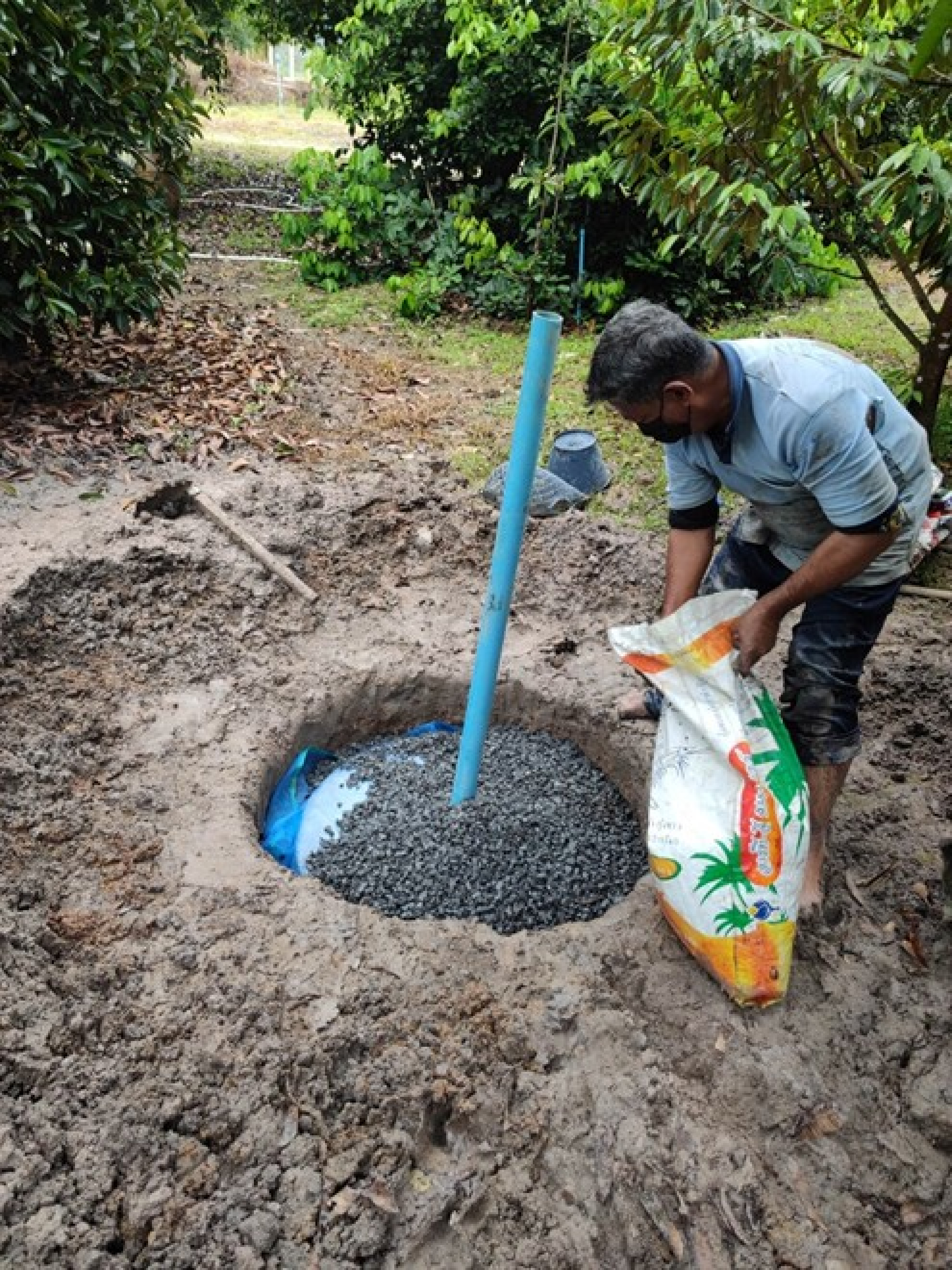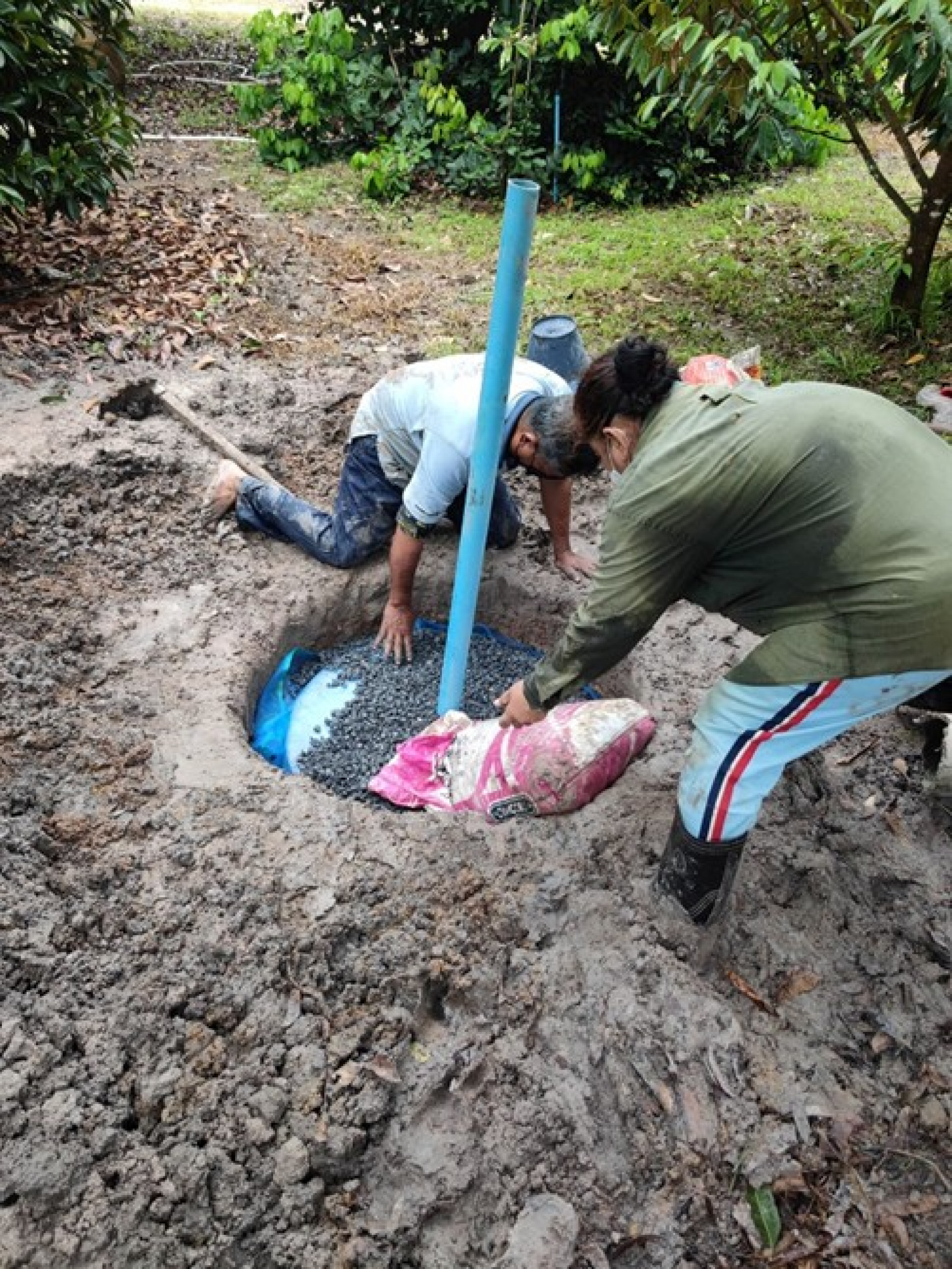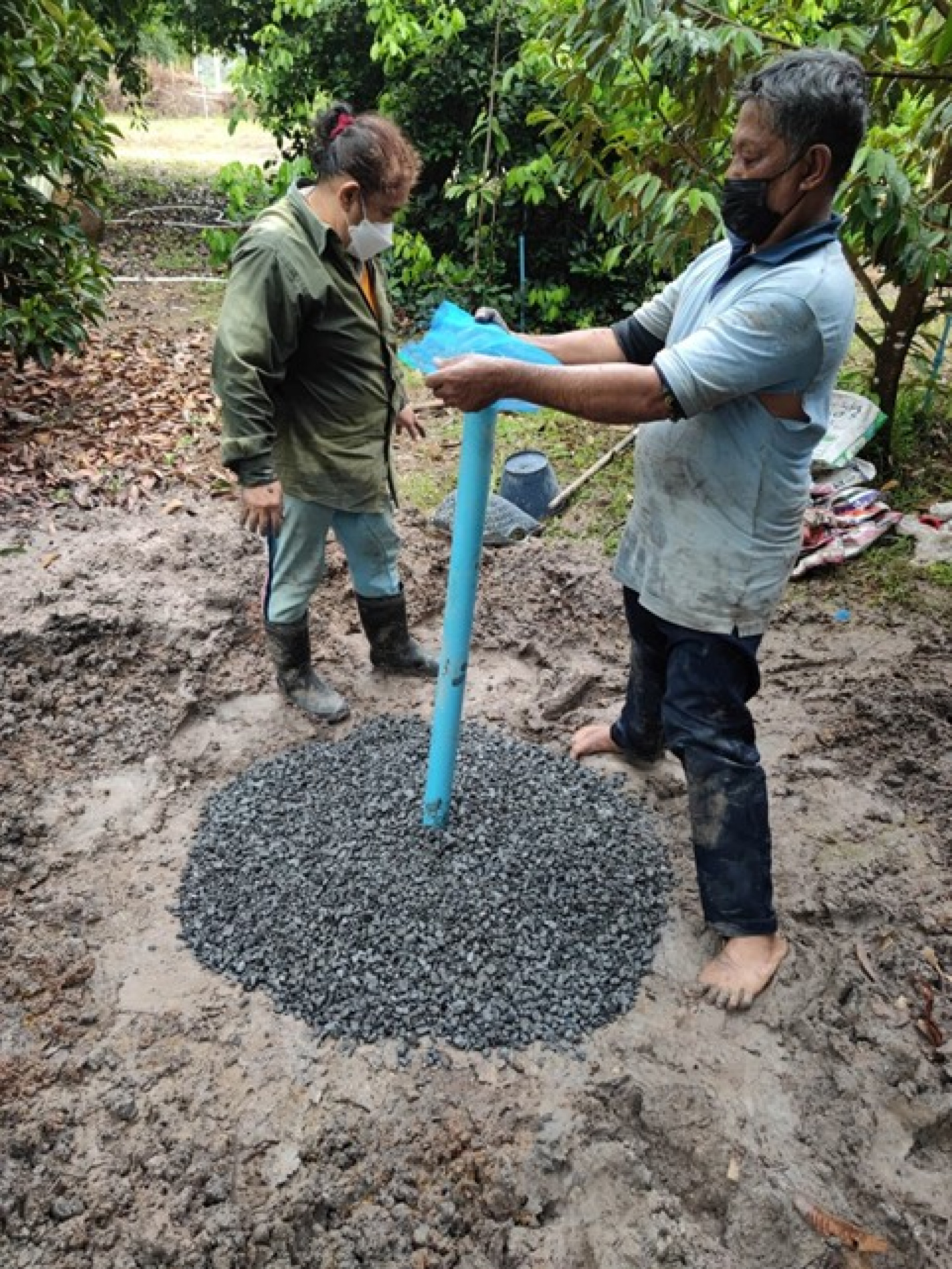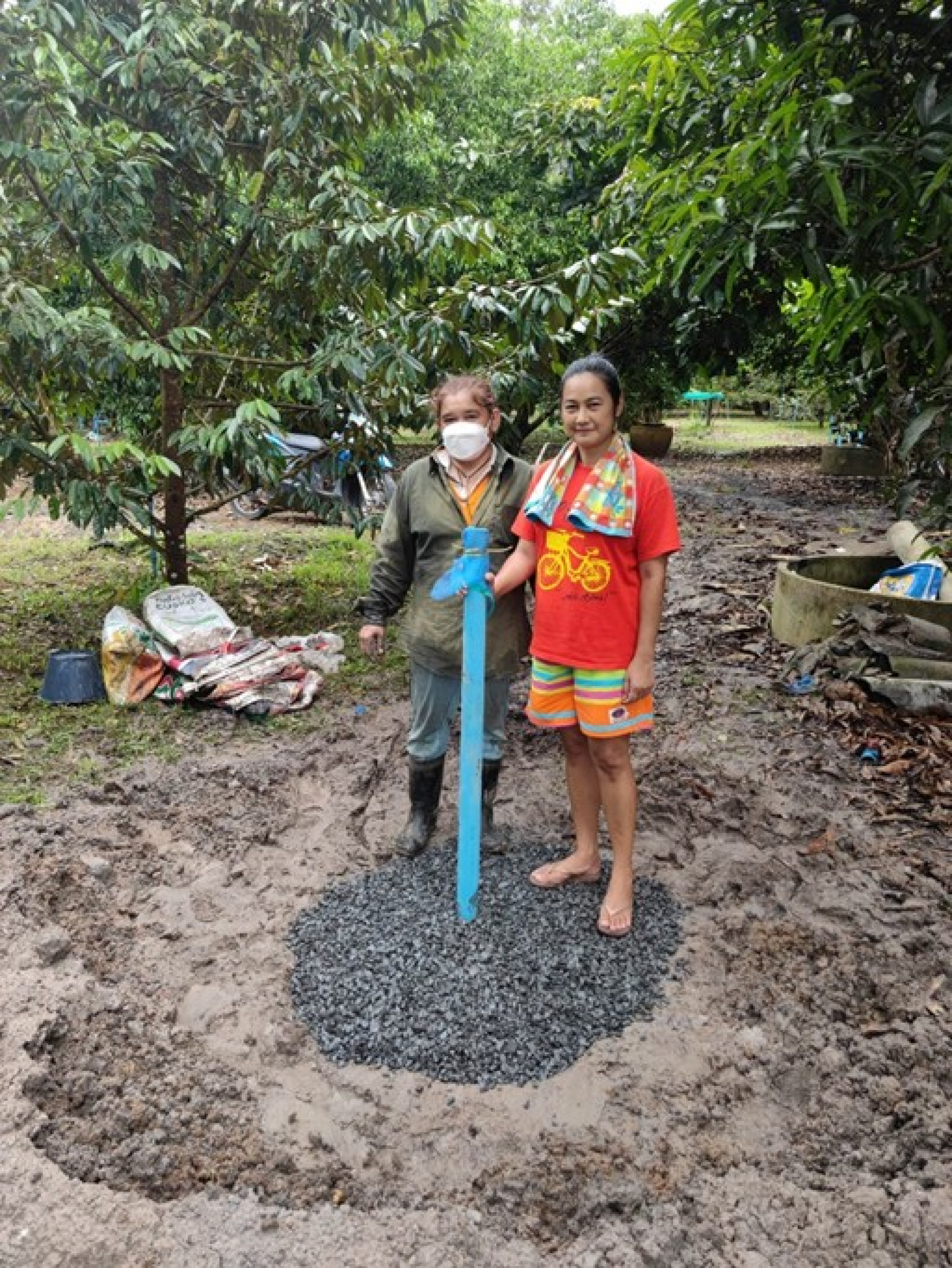





| Target | Indicator | Result |
|---|---|---|

SDG 6
CLEAN WATER AND SANITATION
|
||
| 6.4 By 2030, substantially increase water-use efficiency across all sectors and ensure sustainable withdrawals and supply of freshwater to address water scarcity and substantially reduce the number of people suffering from water scarcity | 6.4.1 Change in water-use efficiency over time |
โดยการประเมินความคุ้มค่าตามหลักของผลประโยชน์ และต้นทุนของธนาคารน้ำใต้ดิน ซึ่งพบว่ามีผลประโยชน์สูงกว่าต้นทุนจนคุ้มค่ากับการจัดการน้ำที่อยู่ในครัวเรือน และสามารถดำเนินการด้วยตนเอง และสามารถเผยแพร่ไปยังครัวเรือนใกล้เคียงในพื้นที่เดียวกัน และก่อเกิดประโยชน์กับครัวเรือนทางด้านการบริหารจัดการน้ำและทั้งการแก้ไขปัญหาน้ำหลากและน้ำแล้งให้บรรเทาลดลง - ระบุจำนวนต้นทุนของการสร้างธนาคารน้ำใต้ดิน |
(ภาษาไทย)
โครงการเผยแพร่แนวคิดธนาคารน้ำใต้ดิน ให้กับชุมชนปากพลี จ.นครนายก และทำการสัมภาษณ์ผู้เข้าร่วมโครงการทางด้านผลประโยชน์ ต้นทุนที่เกิดจากการดำเนินกิจกรรมดังกล่าว
แนวคิดธนาคารน้ำใต้ดินมาจากการจัดระบบน้ำบาดาลให้มีความยั่งยืนด้วยการฝากนไว้ใต้ดินกับธนาคารน้ำใต้ดินทำได้โดย โดยในการขุดต้องขุดให้ผ่านชั้นดินเหนียวไปจนถึงชั้นหินอุ้มน้ำ และที่ตั้งของบ่อให้อยู่ในทิศทางที่รับน้ำฝนที่ตกลงมา จากหลักการเคลื่อนที่ของน้ำที่ไหลจากที่สูงลงสู่ที่ต่ำ และการเคลื่อนที่ของโลกทำให้น้ำใต้ดินไหลลงไปรวมกันและเก็บไว้ในชั้นใต้ดินกลายเป็นน้ำใต้ดินหรือน้ำบาดาล (groundwater) ธนาคารน้ำใต้ดิน ระบบปิดใช้หลักการขุดบ่อเพื่อส่งน้ำไปเก็บไว้ที่ชั้นน้ำบาดาล ขนาดและความลึกของบ่อขึ้นอยู่กับสภาพ และชั้นดินของแต่ละพื้นที่ โดยมีขั้นตอนดังนี้ขุดบ่อให้ลึกถึงชั้นหินอุ้มน้ำ จากนั้นใส่ยางรถยนต์เพื่อป้องกันขอบบ่อพังทลาย จากนั้นใส่วัสดุที่หาได้ในพื้นที่ เช่นขวดน้ำ (ใส่น้ำ 1 ใน 3 ส่วน), ท่อนไม้ หรือเศษปูนให้เต็มช่องว่างด้านนอกยางรถยนต์ นำท่อ PVC มาวางตรงกลางบ่อเพื่อเป็นช่องระบายอากาศ นำวัสดุชนิดเดียวกับที่ใส่ช่องว่างด้านนอกมาเติมใส่ช่องว่างด้านในให้เต็ม คลุมด้วยผ้าไนล่อน แล้วทับด้วยก้อนหิน และตามด้วยหินละเอียดอีกที เพื่อเป็นตัวกรองให้เศษดิน หรือขยะไม่ให้เข้าไปอุดตันในบ่อ เมื่อฝนตกลงมาน้ำจะไหลสู่ชั้นใต้ดินโดยตรง
ประโยชน์ของธนาคารน้ำใต้ดิน
1. ช่วยแก้ปัญหาน้ำท่วมได้ เพราะช่วยให้น้ำซึมลงใต้ดินได้ดีขึ้น
2. ช่วยแก้ปัญหาภัยแล้ง เพราะสามารถสูบน้ำจากธนาคารน้ำใต้ดินใช้ได้ตลอดเวลา
3. แก้ปัญหาน้ำสกปรก เพราะระบบน้ำแบบปิดจะช่วยกรองน้ำให้สะอาดขึ้น
(ภาษาอังกฤษ)
This research project located at Pak Phli community, Nakhon Nayok province and interviewed the participants about the benefit and costs. The underground water bank concept comes from the sustainable arrangement of groundwater systems by depositing them underground with underground water banks. The excavation must be dug through the clay layer to the aquifer. and the location of the pond to be in the direction of receiving rainwater that fell from the principle of movement of water that flows from high to low And the movement of the earth causes groundwater to flow together and store it in the basement to become groundwater. Underground water bank The closed system uses the principle of digging wells to deliver water to the groundwater layer. The size and depth of the well depends on the condition. and the soil layer of each area The steps are as follows: dig a well to the depth of aquifers. Then, put on tires to prevent the edge of the pond from collapsing. Next, fill the gaps outside the tire with a piece of wood, such as a water bottle (1/3 water), a piece of wood, or a piece of cement. Put a PVC pipe in the middle of the pond for ventilation. Take the same material that fills the outer voids to fill the inner voids. covered with nylon then covered with stones and followed by fine stone as a filter for soil debris or garbage not to get clogged in the pond When it rains, the water flows directly into the basement.
Benefits of underground water banks
1. solve flood problems. Because it allows water to seep into the ground better.
2. solve the problem of drought. Because water can be pumped from underground water banks at all times.
3. solve dirty water problems. Because the closed water system will help filter the water more clean.
(ภาษาไทย
ครัวเรือนเข้าร่วมโครงการตระหนักถึงการจัดการระบบน้ำ โดยการประเมินความคุ้มค่าตามหลักของผลประโยชน์ และต้นทุนของธนาคารน้ำใต้ดิน ซึ่งพบว่ามีผลประโยชน์สูงกว่าต้นทุนจนคุ้มค่ากับการจัดการน้ำที่อยู่ในครัวเรือน และสามารถดำเนินการด้วยตนเอง และสามารถเผยแพร่ไปยังครัวเรือนใกล้เคียงในพื้นที่เดียวกัน และก่อเกิดประโยชน์กับครัวเรือนทางด้านการบริหารจัดการน้ำและทั้งการแก้ไขปัญหาน้ำหลากและน้ำแล้งให้บรรเทาลดลง
(ภาษาอังกฤษ)
Households join the project to realize water system management. by evaluating the value based on the principle of benefits and the cost of underground water banks Which found that the benefits are higher than the cost until it is worthwhile to manage water in the household. and can be operated manually and can be disseminated to neighboring households in the same area This will bring benefits to households in terms of water management and to mitigate flooding and drought problems.



